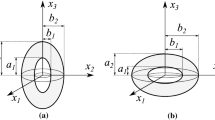Abstract
The orientation-preservation condition, i.e., the Jacobian determinant of the deformation gradient det ∇u being required to be positive, is a natural physical constraint in elasticity as well as in many other fields. It is well known that the constraint can often cause serious difficulties in both theoretical analysis and numerical computation, especially when the material is subject to large deformations. We derive a set of necessary and sufficient conditions for the quadratic iso-parametric finite element interpolation functions of cavity solutions to be orientation preserving on a class of radially symmetric large expansion accommodating triangulations. The result provides a practical quantitative guide for meshing in the neighborhood of a cavity and shows that the orientation-preservation can be achieved with a reasonable number of total degrees of freedom by the quadratic iso-parametric finite element method.
Similar content being viewed by others
References
Bai Y, Li Z P. Numerical solution of nonlinear elasticity problems with Lavrentiev phenomenon. Math Models Methods Appl Sci, 2007, 17: 1619–1640
Ball J M. Discontinuous equilibrium solutions and cavitation in nonlinear elasticity. Philos Trans R Soc London Ser A, 1982, 306: 557–611
Ball J M. A version of the fundamental theorem for Young measures. Lecture Notes in Phys, 1989, 344: 207–215
Ball J M, Knowles G. A numerical method for detecting singular minimizers. Numer Math, 1987, 51: 181–197
Chi H, Talischi C, Lopez-Pamies O, et al. Polygonal finite elements for finite elasticity. Int J Numer Meth Engng, 2015, 101: 305–328
Gent A N, Lindley P B. Internal rupture of bonded rubber cylinders in tension. Proc R Soc London Ser A, 1958, 249: 195–205
Henao D. Cavitation, invertibility, and convergence of regularized minimizers in nonlinear elasticity. J Elast, 2009, 94: 55–68
Lavrentiev M. Sur quelques problems du calcul des variations. Ann Math Pure Appl, 1926, 4: 7–28
Li Z P, A numerical method for computing singular minimizers. Numer Math, 1995, 71: 317–330
Lian Y, Li Z P. A dual-parametric finite element method for cavitation in nonlinear elasticity. J Comput Appl Math, 2011, 236: 834–842
Lian Y, Li Z P. A numerical study on cavitations in nonlinear elasticity-defects and configurational forces. Math Models Methods Appl Sci, 2011, 21: 2551–2574
Lian Y, Li Z P. Position and size effects on voids growth in nonlinear elasticity. Int J Fracture, 2012, 173: 147–161
Lopez-Pamies O, Idiart M I, Nakamura T. Cavitation in elastomeric solids: I—A defect-growth theory. J Mech Phys Solids, 2011, 59: 1464–1487
Müller S. Variational models for microstructure and phase transitions. In: Calculus of Variations and Geometric Evolution Problems. Lecture Notes in Mathematics, vol. 1713. Berlin-Heidelberg: Springer, 1999, 85–210
Müller S, Spector S J. An existence theory for nonlinear elasticity that allows for cavitation. Arch Ration Mech Anal, 1995, 131: 1–66
Negrón-Marrero P V, Betancourt O. The numerical computation of singular minimizers in two-dimensional elasticity. J Comput Phys, 1994, 113: 291–303
Sivaloganathan J. Uniqueness of regular and singular equilibia for spherically symmetric problems of nonlinear elasticity. Arch Ration Mech Anal, 1986, 96: 97–136
Sivaloganathan J, Negro-Marrero P V. The Numerical computation of the critical boundary displacement for radial cavitation. Math Mech Solids, 2009, 14: 696–726
Sivaloganathan J, Spector S J. On cavitation, configurational forces and implications for fracture in a nonlinearly elastic material. J Elast, 2002, 67: 25–49
Sivaloganathan J, Spector S J, Tilakraj V. The convergence of regularized minimizers for cavitation problems in nonlinear elasticity. SIAM J Appl Math, 2006, 66: 736–757
Su C M, Li Z P. A meshing strategy for a quadratic iso-parametric FEM in cavitation computation in nonlinear elasticity. ArXiv:1701.01233, 2017
Su C M, Li Z P. Error Analysis of a Dual-parametric Bi-quadratic FEM in Cavitation Computation in Elasticity. SIAM J Numer Anal, 2015, 53: 1629–1649
Tvergaard V. On cavitation instabilities with interacting voids. Eur J Mech A Solids, 2012, 32: 52–58
Wang Z X, Guo D R. Introduction to Special Functions. Beijing: Peking University Press, 2006
Xu X M, Henao D. An efficient numerical method for cavitation in nonlinear elasticity. Math Models Methods Appl Sci, 2011, 21: 1733–1760
Acknowledgements
This work was supported by National Natural Science Foundation of China (Grant Nos. 11171008 and 11571022).
Author information
Authors and Affiliations
Corresponding author
Rights and permissions
About this article
Cite this article
Su, C., Li, Z. Orientation-preservation conditions on an iso-parametric FEM in cavitation computation. Sci. China Math. 60, 719–734 (2017). https://doi.org/10.1007/s11425-016-0019-0
Received:
Accepted:
Published:
Issue Date:
DOI: https://doi.org/10.1007/s11425-016-0019-0




